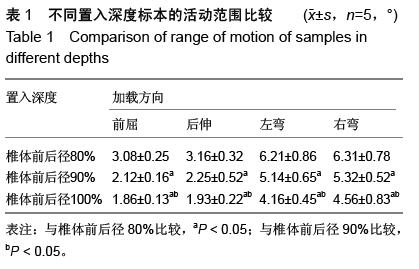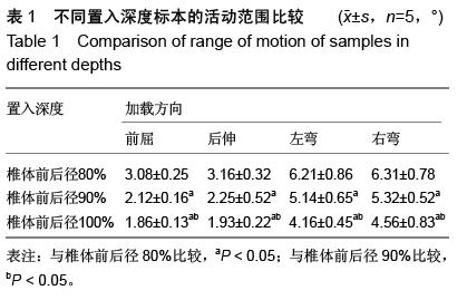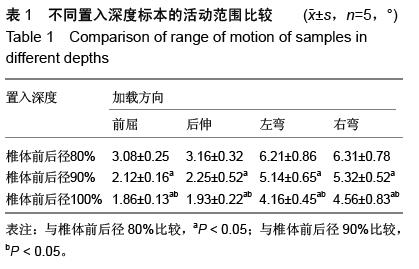| [1] 范小波.关于椎弓根螺钉置入深度对其稳定性影响的生物力学研究[D]. 河北医科大学,2011.
[2] 章筛林,石志才,张晔,等. 骨水泥椎体强化椎弓根钉置入对骨质疏松脊柱生物力学稳定性的影响[J]. 中国组织工程研究与临床康复,2009,13(4): 617-620.
[3] 孙志明.椎弓根螺钉置钉深度在胸腰椎骨折矢状面重建中的生物力学研究[D]. 天津医科大学,2008.
[4] 郑召民. 髂骨钉钉道影像解剖学及髂骨钉在腰-髂重建中的生物力学研究[D].中山大学,2007.
[5] Law M,Tencer AF,Anderson PA. Caudo-Cephalad loading of pedicle scrcws:mechanisms of loosening and methods of augmentation.Spine. 1993;18(16): 2438-2443.
[6] 韩世强. 椎弓根螺钉进钉深度与远期稳定性关系的研究[D].河北北方学院, 2014.
[7] 陈辉,于滨生,郑召民,等.髂骨钉置入深度对腰椎-骨盆重建结构的生物力学影响[J].中华外科杂志,2008,46(15): 1179-1182.
[8] 朱如森,冯世庆,刘岩.脊柱内固定椎弓根螺钉植入后生物力学的稳定性[J].中国组织工程研究,2013,17(17): 3056-3063.
[9] Tokuhashi Y,Ajiro Y,Umezawa N. Outcomes of posterior fusion using pedicle screw fixation in patients>or=70 years with lumbar spinal canal stenosis.Orthopedics. 2008;31(11):1096.
[10] Hee HT,Yu ZR,Wong HK. Comparison of segmental pedicle screw instrumentation versus anterior instrumentation in adolescent idiopathic thoracolumbar and lumbar scoliosis.Spine(Phila Pa 1976). 2007; 32(14):1533-1542.
[11] 崔轶,雷伟,刘达,等.两种椎弓根螺钉钉道强化技术在骨质疏松绵羊椎体的应用[J].医用生物力学,2011,26(2): 150-158.
[12] 王正,沈国平,陈伟兵,等.椎弓根螺钉内固定稳定性的生物力学测试[J].医用生物力学,2002,17(2):80-84.
[13] 林周胜,黄志平,陈建庭,等.棒直径对椎弓根螺钉固定稳定性和脊柱承载影响的生物力学研究[J].实用医学杂志, 2013,29(1):1-3.
[14] 范海涛.骨质疏松性椎体骨折手术治疗进展[J].安徽医科大学学报,2012,47(4):473-476.
[15] Weinstein JN,Spratt KF,Spengler D,et al. Spinal pedicle fixation:reliability and validity of roentgenogram-based assessmentand surgical factors on successful screw placement. Spine. 1988;13(9):1012-1018.
[16] Ashman RB. In vitro spinal arthrodesis implant mechanical testing protocols. J Spinal Dis. 1989; 2(4):274-281.
[17] 李志刚,李建涛.胸腰椎骨折内固定术后椎弓根螺钉折断的原因分析[J].中外健康文摘,2013,35: 42-43.
[18] Austin A, Green S, Ahsan S, et al. Cadaveric Study of Appropriate Screw Length for Distal Radius Stabilization Using Volar Plate Fixation. Am J Orthop (Belle Mead NJ). 2015;44(8):369-372.
[19] Karami KJ, Buckenmeyer LE, Kiapour AM, et al. Biomechanical evaluation of the pedicle screw insertion depth effect on screw stability under cyclic loading and subsequent pullout. J Spinal Disord Tech. 2015;28(3):E133-139.
[20] Bengard MJ, Gardner MJ. Screw depth sounding in proximal humerus fractures to avoid iatrogenic intra-articular penetration. J Orthop Trauma. 2011; 25(10):630-633.
[21] Miyawaki S, Tomonari H, Yagi T, et al. Development of a novel spike-like auxiliary skeletal anchorage device to enhance miniscrew stability. Am J Orthod Dentofacial Orthop. 2015;148(2):338-344.
[22] Chen Z, Wu B, Zhai X,et al. Basic study for ultrasound-based navigation for pedicle screw insertion using transmission and backscattered methods. PLoS One. 2015;10(4):e0122392.
[23] Amaritsakul Y, Chao CK, Lin J. Comparison study of the pullout strength of conventional spinal pedicle screws and a novel design in full and backed-out insertions using mechanical tests. Proc Inst Mech Eng H. 2014;228(3):250-257.
[24] Migliorati M, Signori A, Silvestrini-Biavati A. Temporary anchorage device stability: an evaluation of thread shape factor. Eur J Orthod. 2012;34(5):582-586.
[25] Moon SH, Um HS, Lee JK, et al. The effect of implant shape and bone preparation on primary stability. J Periodontal Implant Sci. 2010;40(5):239-243.
[26] 胡勇,谢辉,徐荣明,等.青少年脊柱侧凸患者胸椎椎弓根螺钉置入的准确性和安全性评价[J].中国脊柱脊髓杂志, 2006,16(11):820-824.
[27] Wadhwa RK, Thakur JD, Khan IS, et al. Adjustment of suboptimally placed lumbar pedicle screws decreases pullout strength and alters biomechanics of the construct: a pilot cadaveric study. World Neurosurg. 2015;83(3):368-375.
[28] Matsukawa K, Yato Y, Imabayashi H, et al. Biomechanical evaluation of the fixation strength of lumbar pedicle screws using cortical bone trajectory: a finite element study. J Neurosurg Spine. 2015;23(4): 471-478.
[29] Calvert GC, Lawrence BD, Abtahi AM, et al. Cortical screws used to rescue failed lumbar pedicle screw construct: a biomechanical analysis. J Neurosurg Spine. 2015;22(2):166-172. |



